#17th c. Spain
Photo

Posthumous portrait of Saint Elizabeth of Aragon, Queen of Portugal (1271-1336) , 17th century
115 notes
·
View notes
Text
Random saints by Sittow or Catherine of Aragon's parents?

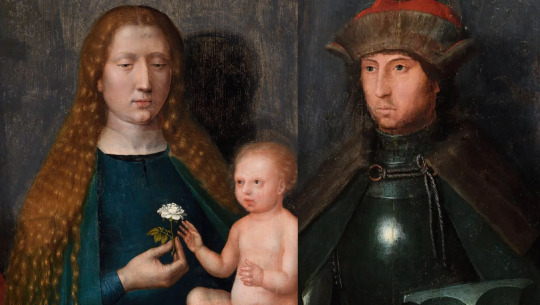
Read further if you wish to know what my theory is.
I first found this photo with mention it is by Sittow and at first I thought it is another portrait of Catherine. But quickly I realised this woman looks older and the features are not exactly the same.
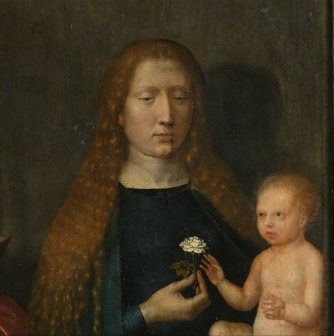
The nose is much narrower. And I started to wonder...we know that Sittow painted at least one portrait of Queen Isabella I of Castile.
And she had such nose. I could exclude possibility some of Catherine's sisters looked like this too, but women in that family tended to be very young-looking for really long.
So the age of sitter already is suggesting that it could be based upon Isabella towards end of her life. And it is also odd for depiction of Virgin Mary to depict woman who is not young...it is point in Isabella's favour.
While many claim Sittow painted Isabella in 1485, he was only born in 1468/1469 and didn't even become indipended master until at least 1488. He is first recorded working in Toledo in 1492. So he'd always be only able to depict Isabella over age of 40. And tbh, if this is her..then she looks great for somebody over 40!
But where is this image? It took me while to track down.
It's detail from wings of theThe Passion Altarpiece (Tallinn), its middle part is from c.1515-1520(with some 17th century additions) by different artist.

But I am not so sure how accurate is the dating of the outer wings by Sittow(1518-1525) which are in very different style, and might have originally belong to different altar middle.

If it is indeed 1518-1525 dating, then imo they are posthumous depictions based upon earlier sketches done from life. Sittow reusing those old sketches, using them as inspiration for his later work.
Link to photos only. Left pannel: https://artsandculture.google.com/asset/the-passion-altarpiece-outer-wing-with-the-virgin-mary-and-apostle-james-the-greater-paintings-of-the-outer-side-of-the-wings-by-michel-sittow-and-his-workshop/BwFnRG1v6gRqmQ
Right pannel: https://arthive.com/artists/75951~Michel_Sittow/works/526786~Saint_Adrian_and_Saint_Anthony
As to where they are located?
-Niguliste Museum(housed in former St. Nicholas' Church), which is part of Art Museum of Estonia(which combines collections from 3 other buildings+ this church). Hence in Tallin, Estonia but be aware there is over 3 km distance in between the church and other buildings.
But if anybody could go there and get us some pictures it'd be great (if it is allowed). Currently Niguliste Museum has exhibition about Sittow:

But back to the pannels. The left one depicts Madonna(Virgin Mary holding baby Jesus) and St. James the Great(apostle and patron saint of Spain:
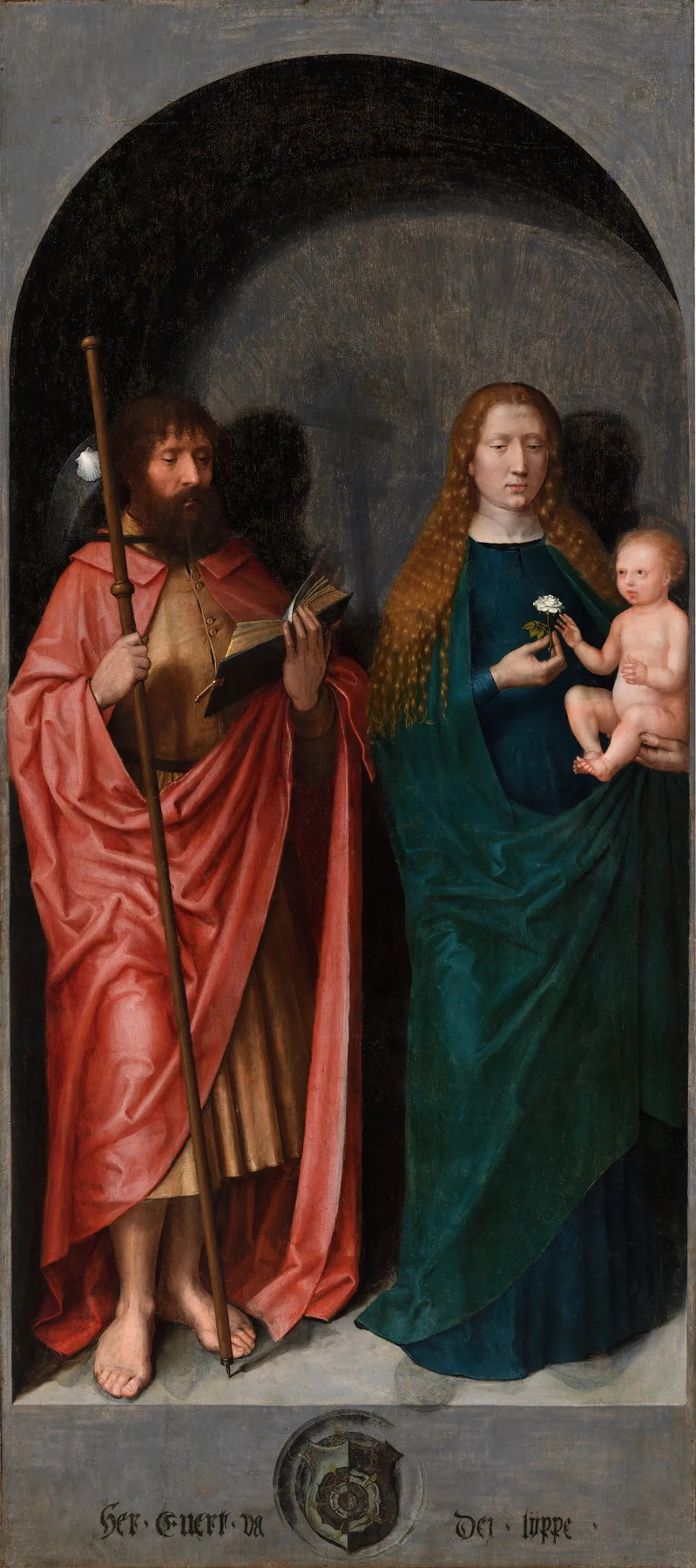
And please note that Tudor rose is combination of red and white rose and not always it was depicted as inner rose white, outer red. Sometimes they were halfed, with inner rose sometiems also switched.

Of course it could be some foreign coat of arms or later alteration.
Right pannel:

Here the coat of arms looks much newer and is probably altered(and if pomegranate turned out to be beneath it, I'd just die...)
The right pannel is depicting two male saints. On right is St Anthony the Great...was father of monasticism(of monastic life)...thus very important saint in christianity...
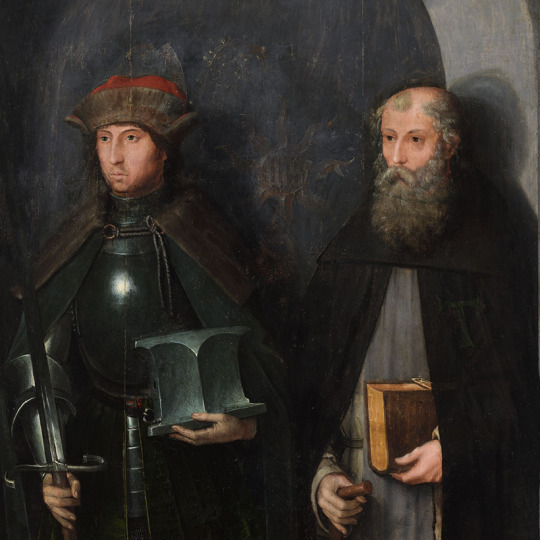
and on left St. Adrian of Nicomedia(2nd most popular military saint after St. George), and imo that's probably King Ferdinand II of Aragon:

It's not great likeness(brows not arched enough, looks bit slimmer, alla of nose not as defined), but overall it's enough of resemblence to not be able to exclude the possibility.
But if this is indeed done years after Sittow was in Spain...and he is reusing his old sketches of catholic monarchs to create this new religious scene(perhaps initially intended for them too, but never made into finished work before), then it is also possible that sketch done in pencil has partially rubbed off...and thus the differences in face of this male.
I think that if this was done while in Spain, such big differences are not very likely to occur. Not that pencil could not rub off, but I think Sittow would have noticed and cared about getting absolutely righ(to please his patrons) and thus would have corrected it.
Ehm, this kitty is supposed to be a lion:
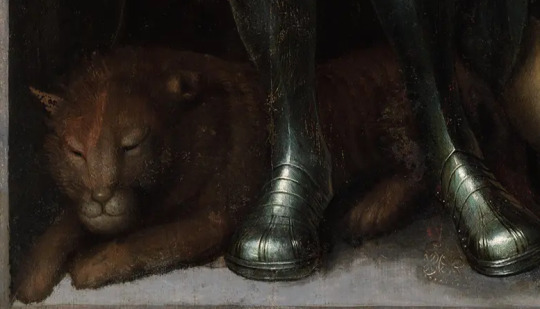
But you must be wondering, if Isabella indeed had this most vivid golden hair colour I always go on and on about, why does she have red hair here?
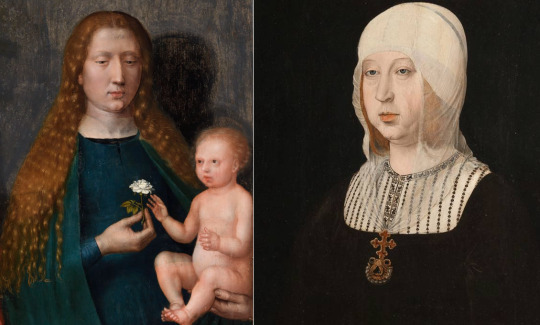
Several options to pick from: Pigments going wrong, Isabella's hair possibly turning to more reddish hues towards end of her life, or simply discoloured pinkish varnish which was very oddly applied...and on baby's skin you can see where somebody applied only one layer and where they went with brush for 2nd time.
If entire pannel has this varnish on, then it'd affect the hair, turning it more red. Why would such varnish not be removed? Sometimes money is tight and museums have multiple paintings to care for and those paintings in fairly good condition have to wait longer.
And sometimes it is not possible to remove discoloured varnish without harming the painting beneath.
Also worth of nothing is that Virgin Mary's dress is typically not teal, but vividly blue, the very best most expensive most vivid blue pigments were very often reserved for depicting the Virgin Mary:

Sometimes due to budget cost cheaper substitues were used, and those tend to fade.
Hence imo the colours originally might have been intended to be more like this(yes, I photoshopped it):

(I didn't change damn thing about male figure, just brightened it. But tbh I played with the woman's dress, skin and hair for while.)
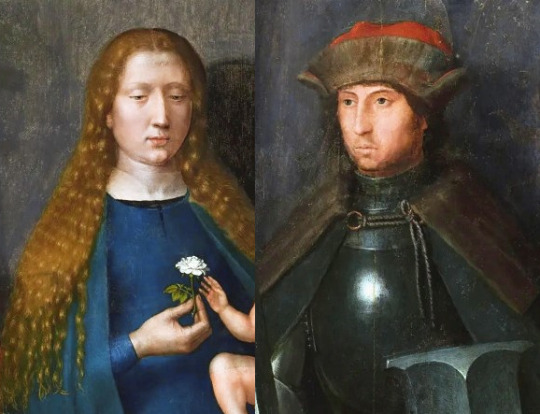
I mean if it looked like this now, fans of catholic monarchs would probably be all over it already.
But people overlook these dark slightly pinkish images located all the way in Estonia, even though it is atributed to Sittow himself!
(I don't mean people in Estonia, I mean people who search for Isabella's lost portrait by Sittow and stubbornly stuck to their favourite which is not even by Sittow!)

I honestly thought that people searching for lost portrait of Isabella by Sittow would have by now checked all his work, to see if perhaps she is there somewhere! Just doesn't look teen or young adult.
So I want you to be aware, if you're on quest of finding Isabella by Sittow's in that portrait with emerald necklace that this is imo the face you're looking for :

Possibly with hair bit more golden and skin more fair:
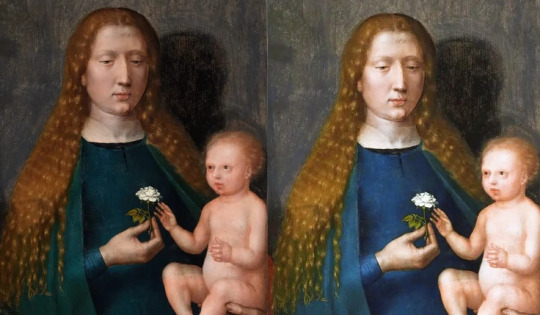
And it doesn't matter she doesn't look 20! She is still very beautiful.
Hence imo, these are Catherine of Aragon's parents, depicted in disguise of saints:

But I think they were likely painted years after Sittow left Spain, and his old sketches of them have been reused to create these pannels. I hope the experts will one day look more into this possibility.
I hope you've enjoyed this, and tell me what you think. Am I onto something or am I chasing shadows?


#historical portraits#isabella of castile#ferdinand of aragon#Isabella I of Castile#Ferdinand II of Aragon#sittow
72 notes
·
View notes
Note
hello caden, do you know anything about horticulture therapy? i'm taking a class on it and there's a big emphasis on how medieval european medicine taught that working in a garden is good for your health (apparently in medieval Spain hospital patients would do it to pay off their debts and they found they had better health outcomes). there's also stuff about dr benjamin rush. i don't know much about him but i am lightly skeptical of everything i've read so far. i'm curious to hear your take
as in, do i think it works, or do i know of it being a therapeutic practice? on the former, basically no, not the way proponents claim. on the latter, yeah horticultural therapy/gardening was commonly prescribed when there were broader turns toward occupational/work therapies, the ideas generally being that patients needed 1) moral discipline of the variety encouraged by physical labour 2) something to focus their minds on 3) exercises that could strengthen the weakened or injured body 4) exposure to fresh air and nature 5) a way of 'contributing to society'. which of these justification/s were used varied by location and time period: eg, in the us and france, there was a pretty dramatic shift in the latter half of the 18th century toward hospital reform that focussed on improving sanitary conditions, and this led to (among other things) a bigger push for outdoor activities, courtyard access, gardens, airflow, &c; also in these countries in this period, certain trendy empiricist ideas were often invoked to justify claims about the moral benefits of physical work, which obviously was very helpful to people who wanted, eg, standing militaries and large workforces in these countries that were dealing with political instability.
benjamin rush was definitely big on horticultural therapy in philadelphia, specifically in the context of psychiatric therapeutics; he was an advocate of occupational/work therapy in general. in the french context in particular, gardens have also had some other specific valences, owing to lockean and rousseauvian ideas about the moral value of seeing / contemplating nature, as well as a fashion for orderly gardens as demonstrations of imperial management of nature & territory from about the 17th century onward. (british gardens have historically had a similar ideological function, though britain is not my wheelhouse.) gardening also had specific political resonances and uses because university and hospital gardens historically functioned as sources of pharmacists' botanicals, and because acclimatising exotic species has long been a state-funded economic enterprise intended both to introduce profitable plants into the metropole and to examine the conditions under which organisms could be adapted to different climates. this was a question of great interest to, eg, governments that were trying to hold and profit from settler colonies. so, there were a lot of different reasons gardening in particular was historically such a big part of occupational therapy prescriptions.
none of this inherently means that working in a garden has zero therapeutic benefit. and i'm obviously coming at this from a historical angle and not a medical one per se. but, when i run across a therapeutic recommendation that has this type of history of being deeply entwined with moral claims, political uses, and capitalist and colonialist exploitation, i'm generally very hesitant about assuming it 'works' without compelling reason to think that the justification / evidence for recommending it has radically changed in some way. i specifically have some reasons to be really suspicious of the claim that horticultural therapy 'worked' in that medieval spanish case you mention (i will throw some methodological notes under a cut in case you care, along with a couple historical texts that are just interesting).
occupational therapies in general are still heavily moralised, and are blatantly aimed at getting people 'back to work' in service to employers and governments that depend on their labour-power. obviously, participating in activities you enjoy is generally good for your overall well-being, and for some people one such activity very well could be gardening. but the idea that gardening has some specific health-promoting essence reeks of assumptions about the morality of physical labour, the idea that illness or unwellness is caused by laziness, &c. justifying the practice by appealing to medieval european hospital therapeutics is not impressive because again, the actual reasons for this therapy being recommended in those contexts were, as a general rule, highly political & politicised; none of this is operating in some ideal realm of 'objective' medico-scientific evidence. and, just to spell it out: occupational therapies are appealing to a lot of physicians and institutions because they make it easy to place the emphasis on patients' individual responsibility to 'better' themselves through hard work, and because they easily slot psychiatric treatment into capitalist ruling ontologies: there's no challenge here to the underlying political-economic conditions that cause and worsen human misery or sickness.
as a side note this is all what i think about whenever i see those tumblr posts that are like "cure your depression by having a hobby and doing something with your hands :) get on the alaskan salmon fishing boat :)" but uh that's neither here nor there i guess
regarding the claim about medieval spanish hospital patients:
it's honestly hard to even evaluate this sort of thing directly in the written historical record. medieval european hospital sources tend to be heavily dominated by physicians' records and treatises (depending on time and place, many/most hospital patients may not have even been literate), which means there's not much by way of patient voices in there. there would also be a huge difference between, say, someone who was committed to an institution for the rest of their life and was made to work in the gardens, versus a wealthy patient who may have been encouraged by a physician to do some work in their own gardens, probably even on their own land. also, as the case in question suggests, occupational/work therapies constantly run into the zone of just being blatant economic exploitation of patients, so when we read these archives with critical eyes, any claim to efficacy of such treatments needs to be pretty heavily scrutinised.
you should also keep in mind that european hospitals have historically not always been institutions that patients were expected to leave: i'm not well-read in spanish medical history specifically, but many european hospitals have historically been more of a 'last resort' type of place, where you basically got admitted if you were dying and had no other options, and/or were sent forcibly because you were indigent or perceived to be causing some sort of 'public nuisance'. if you want to talk health outcomes for such institutions, the confounding factors here are going to be so massive i don't know how you could possibly wade through them to say anything conclusive about whether occupational therapies 'worked', especially given that the written medieval record is, yknow, hundreds of years old and sometimes things do get lost (or were never written down in a permanent place at all). also, those patients who did leave hospitals did not generally, afaik, keep in close contact with their physicians, which would make long-term health outcome tracking of this sort difficult—if anyone even attempted to do it!
there are certainly contexts where local/family physicians kept records on specific patients for a long time, but the sorts of long-term large-scale medical 'studies' we would now expect to see in order to back up claims of therapeutic efficacy just didn't really exist prior to the 19th century or so, partly for logistical / bureaucratic reasons and partly because (speaking generally) european medicine in the middle ages tended to emphasise not universal physiological rules but rather the differences between bodies, with the physician's job being to fine-tune the individual's personal biological balance in order to maintain a state of health. the idea of collecting statistics on a huge population to determine a universal biological condition of health/normality doesn't really become professional orthodoxy until the 18th century at the earliest. this is not to say that medieval european medicine had no normalising function or purpose, but it didn't really work in the exact same way that medicine in the era of social sciences and social statistics does. the way that particular claim about spanish hospitals is framed sounds (to me!) a bit too copacetic with current therapeutic evaluative principles not to raise my eyebrows.
if you care about tracking this down i would suggest you follow whatever footnote or reference this claim came from, and see if the author explained their methodology to evaluate their historical sources (if not, big red flag already lol). you would also want to go footnote-jumping until you find the actual historical source, and with luck, possibly consult it online (many archives these days digitise sources, some even on request! everybody say thank you archivists) and make your own evaluations. but ^^ those are just some considerations i would start with and that make me think this claim may lack historical rigour or rely on shoddy evaluation of sources.
a few books off the top of my head that talk about on gardens, gardening, and occupational/nature therapy in general (sorry they're basically all french context):
Sun-Young Park, Ideals of the body: architecture, urbanism, and hygiene in postrevolutionary Paris
Chandra Mukerji, Territorial ambitions and the gardens of Versailles; and "Entrepreneurialism, land management, and cartography during the age of Louis XIV" in Merchants and marvels ed. Paula Findlen & Pamela Smith
Dora Weiner, The citizen-patient in revolutionary Paris
Jessica Riskin, Science in the age of sensibility: the sentimental empiricists of the French Enlightenment
Emma Spary, Utopia's garden: French natural history from Old Regime to Revolution
Sarah Easterby-Smith, Cultivating commerce: cultures of botany in Britain and France, 1760–1815
#welcome to my blog where i tell you what's wrong with your professor's curriculum ig#book recs#ableism
37 notes
·
View notes
Text
Gilt leather shoes in 16th c. Ireland
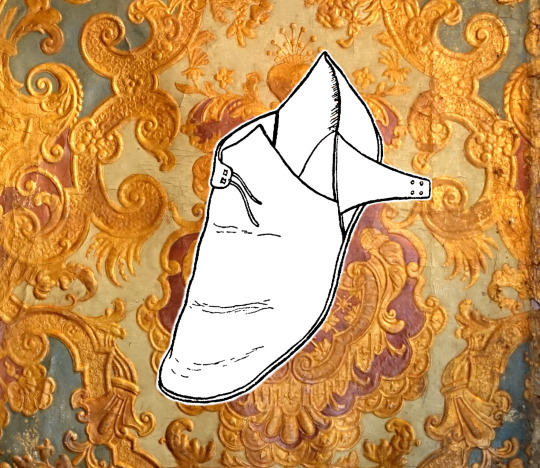
Drawing of a 16th c. Irish shoe by A. T. Lucas over a gilt leather wall hanging from the National Museum Machado de Castro in Portugal
In his 1518 description of Irish clothing, Laurent Vital says the following about shoes worn by Irish women and girls:
Elles portent petits soliers à singles semelles, bien jolys et mignotz, ouvrés pardessus d'aultres couleur de cuyr et parfois doretz de cuyr estainnet, comme s'il estoit doré, et comme j'ay veu porter les enffans parcy-devant, quant on leur achetoit des soliers de ducasse.
They wear little shoes with single soles, very pretty and cute, finely worked on top with other colors of leather and sometimes adorned with gilt leather, as if they were gilded, like the shoes which were bought for children at fairs in past times.
(translation by Dorothy Convery, edited by me)
In this post, I discuss what Laurent Vital meant by gilt leather and how it might have been used in 16th c. Irish shoes.
Sadly, we do not have any surviving examples of gilt leather shoes from medieval or early modern Ireland. This is unsurprising, because gilt leather is a fragile material which can be destroyed by excessive moisture, (Gilt Leather Society 2019) and most surviving Irish shoes have been found in damp locations like bogs, crannogs, and wells (Lucas 1956, Miller 1991, Nicholl 2023).
As Vital points out, although medieval doretz de cuyr or gilt leather looks like gilding, it is not really gold. Gilt leather was made from carefully prepared leather that was sealed with rabbit-skin glue and then had silver foil placed on top of it. The foil was then painted with a yellow varnish, giving it its golden appearance (Pereira 2012). Gilt leather could be stamped with patterns or painted with designs.
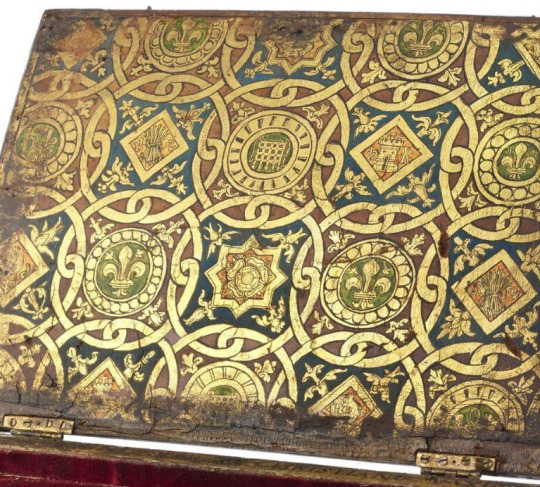
Painted gilt leather on a writing box belonging to King Henry VIII, made circa 1525 Victoria and Albert Museum collection
Learning what gilt leather actually was left me puzzled as to how the Irish made shoes out of it. Early 16th c. Irish shoes were largely made using a turnshoe or turn-welt construction. These methods involve sewing the shoe together inside out and then turning it right side out. In order to turn successfully, the shoe leather needs to be thin and flexible. Turnshoes are typically soaked in water to soften them before they are turned (Miller 1991, Nicholl 2023). I would expect that the layers of rabbit-skin glue and varnish in gilt leather would make the leather too stiff to turn. Also, as previously noted, being soaked with water is bad for gilt leather.
Although there are no surviving Irish examples of gilt leather shoes, there are a few continental European examples of episcopal sandals from the 12-13th centuries which appear to be embellished with gilt leather.
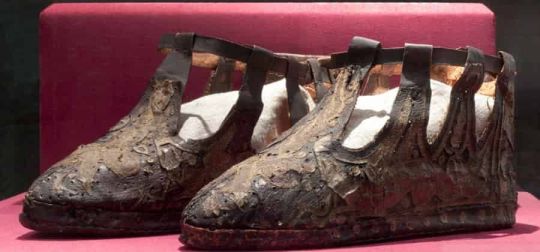


All of these shoes have a base layer of plain leather; the gilt leather is an applique which is glued or stitched on top. This method of construction is consistent with Vital's description that Irish shoes were estainnet i.e. adorned or plated*, with gilt leather. This method also explains how it was possible for Irish shoemakers to make shoes with gilt leather. Turnshoes of plain leather could be appliqued with gilt after they were turned right side out.
*estainnet: modern French étamer: to tin plate or to plate with metal
Irish shoemakers probably used gilt leather that was imported from Spain. During the Middle Ages, gilt leather was made in Spain and Portugal. It was not made elsewhere in Europe until the 17th century. (Pereira 2012). 16th c. Irish merchants imported luxury goods like silk and wine from Spain (Flavin 2011).
Neither Vital's account nor period illustrations give us any idea what kind of designs these Irish gilt shoes had on them. Rinceaux or scrolling foliage motifs like those on the sides of the 16th c. St. Brigid's shoe shrine are a likely option.
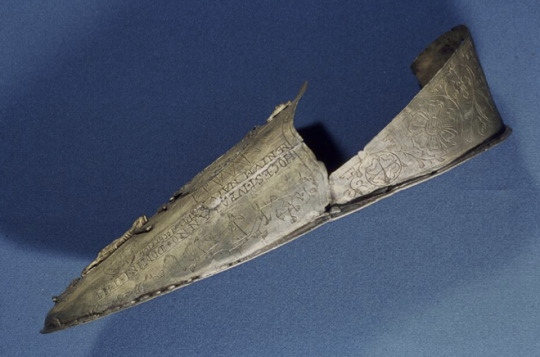
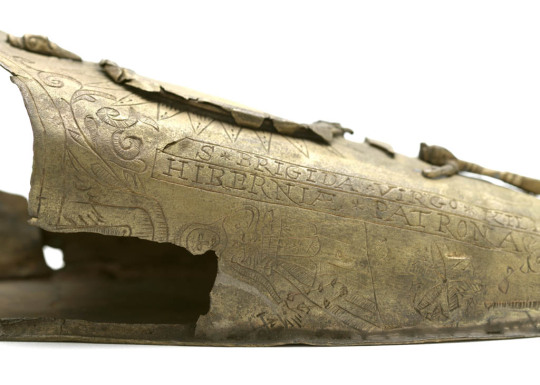
Further reading: Robert Gresh of the group Wilde Irish has written an interesting article on evidence for the use of gilt leather in 16th c. Irish armor. Download here
Bibliography:
Dictionnaire du Moyen Français 2020
Flavin, Susan (2011). Consumption and Material Culture in Sixteenth-Century Ireland. [Doctoral thesis]. University of Bristol.
The Gilt Leather Society. (2019). Conservation Challenges. https://giltleathersociety.org/conservation/conservation-challenges/
Lucas, A. T. (1956). Footwear in Ireland. Journal of the County Louth Archaeological Society, 13(4), 309-394. https://www.jstor.org/stable/27728900
Miller, O. G. (1991). Archaeological Investigations at Salterstown, County Londonderry, Northern Ireland. [Doctoral thesis]. University of Pennsylvania.
Nicholl, John (2023). https://broguesandshoes.com/
Pereira, Franklin (2012). Gilt leather/guadameci in Coimbra – comments on documents of the 12th and 16th centuries. Boletim do Arquivo da Universidade de Coimbra, 15, 169-180. http://hdl.handle.net/10316.2/5514
Ryan, Trisha (2022). Online Pop Up Talk: St. Brigid's Shoe Shrine. National Museum of Ireland Archaeology. https://www.museum.ie/en-IE/Museums/Archaeology/Engage-And-Learn/For-Adults/Online-Pop-Up-Talk-St-Brigid-s-Shoe-Shrine
Vital, Laurent (1518). Archduke Ferdinand's visit to Kinsale in Ireland, an extract from Le Premier Voyage de Charles-Quint en Espagne, de 1517 à 1518. http://research.ucc.ie/celt/document/T500000-001
#irish dress#dress history#16th century#gaelic ireland#historical fashion#shoes#historical women's fashion#irish history#brog#anecdotes and observations
7 notes
·
View notes
Text

The Expulsion of Hagar
Artist: Jan Mostaert (Dutch, c. 1475–1552/1553)
Title: The Banishment of Hagar and Ishmael (Genesis 21:18-21)
Date: c. 1520
Genre: Religious Art
Collection: Museo Nacional Thyssen-Bornemisza, Madrid, Spain
Genesis 21:18-21 (New International Version)
"Lift the boy up and take him by the hand, for I will make him into a great nation.”
Then God opened her eyes and she saw a well of water. So she went and filled the skin with water and gave the boy a drink.
God was with the boy as he grew up. He lived in the desert and became an archer. While he was living in the Desert of Paran, his mother got a wife for him from Egypt.
Jan Mostaert was a painter of considerable renown, primarily known for his religious compositions and portraits. His work is characterised by a minute rendering of the details in a manner that can be related to manuscript painting. The backgrounds of his works are normally landscapes and reveal the evident influence of Joachim Patinir. This painting is a fine example of his narrative skills and includes various episodes from the same story, namely the Expulsion of Hagar as related in the Old Testament. The principal image is that of Abraham at the moment of sending away Hagar and their son Ishmael. Behind this scene are various episodes in which the story continues. On the left we see Abraham’s wife Sarah, looking from her front door at the scene of the expulsion, which she instigated. On the right are various moments in Hagar’s journey including the appearance of the angel that gave them water to drink and the episode of the sacrifice of Isaac, Abraham and Sarah’s son, taking place on a hilltop in the distance. The subject of the Expulsion of Hagar was extremely popular in the Low Countries in the 16th and 17th centuries.
#religious art#jan mostaert#dutch painter#landscape#desert#hagar#ishmael#abraham#old testament#bible verse#bible scripture#oil painting#christianity#christian art#christian faith
3 notes
·
View notes
Text
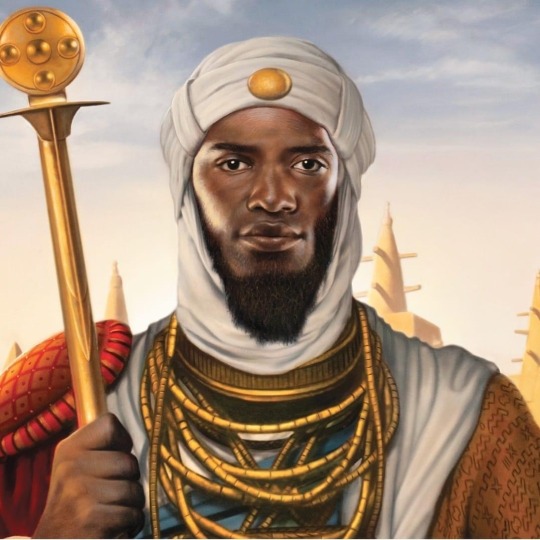
White people ask, why has there never been a powerful African nation like Rome, Persia, or the Aztecs?
Wait, seriously? “Never been a powerful African nation," says who exactly?
I’d presume you’ve never heard of some of these before:
ZULU KINGDOM. They crushed the British in their first battle and wrecked havoc on the Boers.The Zulu Kingdom, sometimes referred to as the Zulu Empire or the Kingdom of Zululand, was a monarchy in Southern Africa that extended along the coast of the Indian Ocean from the Tugela River in the south to Pongola River in the north.
MALIAN EMPIRE. Home to one of the richest Kings in human history. The Mali Empire was an empire in West Africa from c. 1226 to 1670. The empire was founded by Sundiata Keita and became renowned for the wealth of its rulers, especially Mansa Musa. The Manding languages were spoken in the empire.
KINGDOM OF AXUM. One of the centers of African civilization centuries before any European civilization. The Kingdom of Aksum, also known as the Kingdom of Axum or the Aksumite Empire, was a kingdom centered in Northeast Africa and South Arabia from Classical antiquity to the Middle Ages.
ANCIENT EGYPT. One of the centers of civilization. The civilization of ancient Egypt began in the Nile River valley of northeastern Africa. Ancient Egypt was one of the world's first civilizations. It is also one of the most famous civilizations in history.
KINGDOM OF KUSH. Which has more pyramids than Egypt by the way. The Kingdom of Kush was an ancient kingdom in Nubia, centered along the Nile Valley in what is now northern Sudan and southern Egypt. The region of Nubia was an early cradle of civilization, producing several complex societies that engaged in trade and industry.
THE KINGDOM OF DAHOMEY - This was a West African kingdom located within present-day Benin that existed from approximately 1600 until 1904.
THE KINGDOM OF BENIN - Also known as the Edo Kingdom, or the Benin Empire was a kingdom within what is now southern Nigeria. It has no historical relation to the modern republic of Benin, which was known as Dahomey from the 17th century until 1975.
THE GHANAIAN EMPIRE - Also known as Wagadou (Arabic: غانا) or Awkar, was a West African empire based in the modern-day southeast of Mauritania and western Mali that existed from c. 300 until c. 1100. The Empire was founded by the Soninke people, and was based in the capital city of Koumbi Saleh.
KONGO KINGDOM. Prior to the Portuguese arrival, Kongo was developed with a large commercial network. The kingdom melted copper and gold and traded it with products such as raffia cloth and pottery. The kingdom was a superpower and center of trade routes for ivory, copper, raffia cloth, and pottery.
ASHANTI EMPIRE. One of the most powerful and wealthiest states of the 18th-19th century.
The Asante Empire, today commonly called the Ashanti Empire, was an Akan state that lasted between 1701 to 1901, in what is now modern-day Ghana. It expanded from the Ashanti Region to include most of Ghana as well as parts of Ivory Coast and Togo.
The various African Kingdoms and empires were quite well known in Imperial Persia. The Sassanid & Nubian Kings in particular were quite familiar with each other. In fact, Persian traders and travelers extensively traveled the coastlines of modern-day East & North Africa bringing back various cuisines, spices, technologies, and in certain instances; slaves and laborers. Many Africans who came to Iran even became highly skilled soldiers and commanders in the Imperial Sassanid Army.
Moors is a term generally used by Europeans to describe the Muslim people of North Africa and the Iberian Peninsula during the Middle Ages. Between 711 C.E. and 1492 C.E. Muslim people of African descent controlled parts of Iberia which consist of modern-day Spain and Portugal, they ruled and civilized Europe.
Since the Moors ruled Spain for about 800 years, they had time to bring scientific techniques to Europe such as the astrolabe, a device to measure the position of the planets and stars. There was scientific progress in chemistry, mathematics, philosophy, astronomy, physics, and more.
Africans share strong historic ties with Turkey as the Ottoman Empire, its predecessor state, not only recruited tens of thousands of Africans into its army but also employed a large number of them in both the royal court and palace.
68 notes
·
View notes
Photo


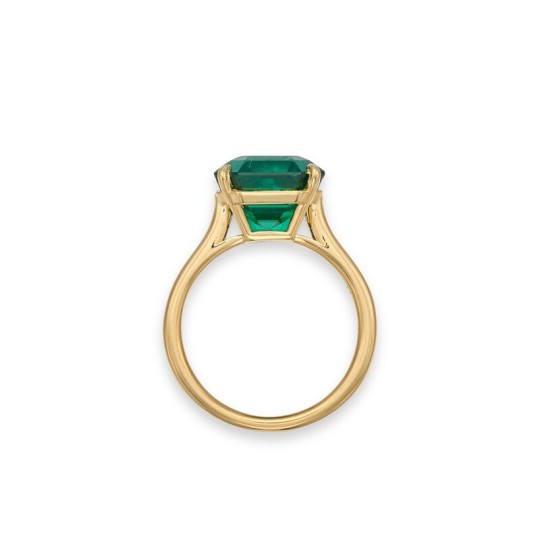

A Historically Significant Emerald Ring
Featuring a square emerald-cut emerald weighing 5.27 carats, size 5¾, signed Valentin Magro.
A ring with a 400-year-old emerald from the 1622 Nuestra Señora de Atocha galleon shipwreck was put up for auction by Sotheby's to raise funds for humanitarian relief efforts in Ukraine. Its owner, Mitzi Perdue visited Ukraine this past summer.
The extraordinary treasures of the Nuestra Señora de Atocha reflect the unimaginable wealth and vast domain within the New World that Spain controlled in the early 17th century. When the overladen Spanish galleon tragically wrecked on a coral reef and sank off the Florida coast amidst a hurricane in 1622, the ship’s hold contained some 180,000 coins and 24 tons of ingots struck from Bolivian silver as well as 125 bars of gold bullion extracted from the Caribbean, Mexico and the Andes amongst its many treasures.
In addition to precious metals, the ship’s detailed log recorded an astonishing 70 pounds of rough-cut emeralds mined from Colombian sources in Chivor and Muzo which the Spanish had first learned of in the early 16th century. As Spain introduced these gems to a European and, in time, a global audience, their shocking depth of color, size, and clarity were unlike anything previously known from the long depleted Egyptian mines of antiquity.
After spending 363 years lost and submerged, the Atocha wreck (as it came to be known) captured the world’s attention when news first broke of its discovery in 1985. Long time treasure hunter Mel Fisher and his team had steadfastly searched an area off the coast of Florida for 16 years, weathering the loss of friends and family in the pursuit, before finally locating the remains of the ship and its precious cargo. These efforts required the belief and patronage of many individuals, amongst them Frank Perdue who was an early believer and fellow enthusiast of Atocha history.
The present lot is set with an expertly cut stone faceted from an emerald crystal recovered from the Atocha. In 1988, Mel Fisher and Frank Perdue worked with famed emerald lapidaries Reginald C. Miller and Jerrold Green of New York to select the best possible emerald crystals from their collection so that a fine gem could be cut for each of them. The resulting 5.27-carat stone was set in gold and proudly presented by Frank to his wife Mitzi as a cherished engagement present and in remembrance of this tremendous undertaking.
#A Historically Significant Emerald Ring#5.27 carat square emerald-cut emerald#1622 Nuestra Señora de Atocha galleon shipwreck#Atocha galleon treasure#treasure#shipwreck#spanish galleon#archeology#archeolgst#ancient artifacts#jewelry#history#history news#ancient history#ancient culture#ancient civilizations#long reads
39 notes
·
View notes
Text
Port Royal
Port Royal is a town located at the end of the Palisadoes, at the mouth of Kingston Harbour, in southeastern Jamaica. Founded in 1494 by the Spanish, it was once the largest city in the Caribbean, functioning as the centre of shipping and commerce in the Caribbean Sea by the latter half of the 17th century.[1] It was destroyed by an earthquake on 7 June 1692, which had an accompanying tsunami, leading to the establishment of Kingston, which is now the largest city in Jamaica. Severe hurricanes have regularly damaged the area. Another severe earthquake occurred in 1907.
Port Royal was once home to privateers who were encouraged to attack Spanish vessels, at a time when smaller European nations were reluctant to attack Spain directly. As a port city, it was notorious for its gaudy displays of wealth and loose morals. It was a popular homeport for the English and Dutch-sponsored privateers to spend their treasure during the 17th century. When those governments abandoned the practice of issuing letters of marque to privateers against the Spanish treasure fleets and possessions in the later 16th century, many of the crews turned pirate. They continued to use the city as their main base during the 17th century. Pirates from around the world congregated at Port Royal, coming from waters as far away as Madagascar.
After the 1692 disaster, Port Royal's commercial role was steadily taken over by the nearby town (and later, city) of Kingston. Plans were developed in 1999 to redevelop the small fishing town as a heritage tourism destination to serve cruise ships. The plan was to capitalize on Port Royal's unique heritage, with archaeological findings from pre-colonial and privateering years as the basis of possible attractions.[1]
CLIMATE
Port Royal has a tropical savanna climate (Köppen climate classification Aw) with a short dry season from January to April and a lengthy wet season from May to October. Temperatures remain steady throughout the year with the dry season being slightly cooler and range from 25.5 °C (77.9 °F) in January to 27.7 °C (81.9 °F) in May. The average annual precipitation is 1,345 millimetres (53 in).[2]
HISTORY
The Taino historic indigenous people of the Caribbean occupied this area for centuries before European settlement. They used the area, which they called Caguay or Caguaya,[3] during their fishing expeditions. Although it is not known whether they ever settled at the spot, they did inhabit other parts of Jamaica.[4]
Colonisation
The Spanish first landed in Jamaica in 1494 under the leadership of Christopher Columbus, leading to the destruction of the Taino population. Permanent settlement occurred when Juan de Esquivel brought a group of settlers in 1509. They came in search of new lands and valuable resources, like gold and silver. Instead they began to cultivate and process the sugar cane. Much like the Taino before them, the Spanish did not appear to have much use for the Port Royal area. They did, however, retain its Taino name.[3] Spain kept control of Jamaica mostly so that it could prevent other countries from gaining access to the island, which was strategically situated within the trade routes of the Caribbean. Spain maintained control over the island for 146 years, until the English took control following their invasion of 1655.
The town was captured by England in 1655 during the invasion of Jamaica.[4][5] By 1659 two hundred houses, shops and warehouses had been built around the fort; by 1692 five forts defended the port.[6] The English initially called the place Cagway but soon renamed it as Port Royal.[3] For much of the period between the English conquest and the 1692 earthquake, Port Royal served as the unofficial capital of Jamaica, while Spanish Town remained the official capital. In 1872 the government designated Kingston, the largest city, as the capital.[6]
Piracy
Port Royal provided a safe harbour initially for privateers and subsequently for pirates plying the shipping lanes to and from Spain and Panama. Buccaneers found Port Royal appealing for several reasons. Its proximity to trade routes allowed them easy access to prey, but the most important advantage was the port's proximity to several of the only safe passages or straits giving access to the Spanish Main from the Atlantic.[6] The harbour was large enough to accommodate their ships and provided a place to careen and repair these vessels. It was also ideally situated for launching raids on Spanish settlements. From Port Royal, Christopher Myngs sacked Campeche and Henry Morgan attacked Panama, Portobello, and Maracaibo. Additionally, buccaneers Roche Brasiliano, John Davis and Edward Mansvelt used Port Royal as a base of operations. In 1657, as a solution to his defence concerns, Governor Edward D'Oley invited the Brethren of the Coast to come to Port Royal and make it their home port. The Brethren was made up of a group of pirates who were descendants of cattle-hunting boucaniers (later anglicized to buccaneers), who had turned to piracy after being robbed by the Spanish (and subsequently thrown out of Hispaniola).[5] These pirates concentrated their attacks on Spanish shipping, whose interests were considered the major threat to the town.
These pirates later became legal English privateers who were given letters of marque by Jamaica's governor. Around the same time that pirates were invited to Port Royal, England launched a series of attacks against Spanish shipping vessels and coastal towns. By sending the newly appointed privateers after Spanish ships and settlements, England had successfully set up a system of defence for Port Royal. Spain was forced to continually defend their property, and did not have the means with which to retake its land.[5]
Spain could not retake the island and, due to pirates, could no longer regularly provide their colonies in the New World with manufactured goods. The progressive irregularity of annual Spanish fleets, combined with an increasing demand by colonies for manufactured goods, stimulated the growth of Port Royal. Merchants and privateers worked together in what is now referred to as "forced trade." Merchants would sponsor trading endeavors with the Spanish, while also sponsoring privateers to attack Spanish ships and rob Spanish coastal towns.[5] While the merchants most certainly had the upper hand, the privateers were an integral part of the operation.
Nuala Zahedieh, a lecturer at the University of Edinburgh, wrote,
"Both opponents and advocates of so-called 'forced trade' declared the town's fortune had the dubious distinction of being founded entirely on the servicing of the privateers' needs and highly lucrative trade in prize commodities."[7] . . . "A report that the 300 men who accompanied Henry Morgan to Portobello in 1668 returned to the town with a prize to spend of at least £60 each (two or three times the usual annual plantation wage) leaves little doubt that they were right".[7]
The forced trade became almost a way of life in Port Royal. Michael Pawson and David Busseret wrote "...one way or the other nearly all the propertied inhabitants of Port Royal seem to have an interest in privateering."[8] Forced trade was rapidly making Port Royal one of the wealthiest communities in the English territories of North America, far surpassing any profit made from the production of sugar cane. Zahedieh wrote, "The Portobello raid [in 1668] alone produced plunder worth £75,000, more than seven times the annual value of the island’s sugar exports, which at Port Royal prices did not exceed £10,000 at this time."[7]
Since the English lacked sufficient troops to prevent either the Spanish or French from seizing it, the Jamaican governors eventually turned to the pirates to defend the city.[9] By the 1660s the city had, for some, become a pirate utopia and had gained a reputation as the "Sodom of the New World", where most residents were pirates, cutthroats, or prostitutes. When Charles Leslie wrote his history of Jamaica, he included a description of the pirates of Port Royal:
Wine and women drained their wealth to such a degree that [...] some of them became reduced to beggary. They have been known to spend 2 or 3,000 pieces of eight in one night; and one gave a strumpet 500 to see her naked. They used to buy a pipe of wine, place it in the street, and oblige everyone that passed to drink.
The taverns of Port Royal were known for their excessive consumption of alcohol such that records even exist of the wild animals of the area partaking in the debauchery. During a passing visit, famous Dutch explorer Jan van Riebeeck is said to have described the scenes:
The parrots of Port Royal gather to drink from the large stocks of ale with just as much alacrity as the drunks that frequent the taverns that serve it.
There is even speculation in pirate folklore that the infamous Blackbeard (Edward Teach) met a howler monkey, while at leisure in a Port Royal alehouse, whom he named Jefferson and formed a strong bond with during the expedition to the island of New Providence.[citation needed] Recent genealogical research indicates that Blackbeard and his family moved to Jamaica where Edward Thatch, Jr. is listed as being a mariner in the Royal Navy aboard HMS Windsor in 1706.[10] Port Royal benefited from this lively, glamorous infamy and grew to be one of the two largest towns and the most economically important port in the English colonies. At the height of its popularity, the city had one drinking house for every 10 residents. In July 1661 alone, 40 new licenses were granted to taverns. During a 20-year period that ended in 1692, nearly 10,000 people lived in Port Royal. In addition to prostitutes and buccaneers, there were four goldsmiths, 44 tavern keepers, and a variety of artisans and merchants who lived in 2,000 buildings crammed into 51 acres (21 ha) of real estate. 213 ships visited the seaport in 1688. The city's wealth was so great that coins were preferred for payment over the more common system of bartering goods for services.
Following Henry Morgan's appointment as lieutenant governor, Port Royal began to change. Pirates were no longer needed to defend the city. The selling of slaves took on greater importance. Upstanding citizens disliked the reputation the city had acquired. In 1687, Jamaica passed anti-piracy laws. Consequently, instead of being a safe haven for pirates, Port Royal became noted as their place of execution. Gallows Point welcomed many to their death, including Charles Vane and Calico Jack, who were hanged in 1720. About five months later, the famous woman pirate Mary Read died in the Jamaican prison in Port Royal. Two years later, 41 pirates met their death in one month.[11]
The Royal Navy
Under British rule the Royal Navy made use of a careening wharf at Port Royal and rented a building on the foreshore to serve as a storehouse. From 1675, a resident Naval Officer was appointed to oversee these facilities;[12] however, development was cut short by the 1692 earthquake. After the earthquake, an attempt was made to establish a naval base at Port Antonio instead, but the climate there proved disagreeable. From 1735, Port Royal once more became the focus of the Admiralty's attention. New wharves and storehouses were built at this time, as well as housing for the officers of the Yard. Over the next thirty years, more facilities were added: cooperages, workshops, sawpits, and accommodation (including a canteen) for the crews of ships being careened there.[13] A Royal Naval Hospital was also established on land a little to the west of the Naval Yard; and by the end of the 18th century a small Victualling Yard had been added to the east (prior to this ships had had to go to Kingston and other settlements to take on supplies).[13]
At the start of the 19th century, a significant amount of rebuilding took place in what was by now a substantial Royal Navy Dockyard serving the fleet in the Caribbean. A sizeable storehouse with a clocktower formed the centrepiece, with a covered way leading from it to the careening wharves. The adjacent Port Admiral's (later Commodore's) House included a watch tower, to counter the threat of privateers. The Yard continued to expand to meet the new requirements of steam-powered vessels: the victualling wharf became a coaling depot in the 1840s, and twenty years later a small engineering complex was built.[13] The Yard continued to expand through to the beginning of the 20th century, but then (with the Admiralty focusing more and more on the situation in Europe) the Navy withdrew from its station in Jamaica and the Dockyard closed in 1905.
Many of the Dockyard buildings (most of which were of timber construction) were subsequently demolished or destroyed (some in the 1907 Kingston earthquake, others by Hurricane Charlie in 1951).[14] A few remain in place, however, including the Naval Hospital complex, some of the steam engineering buildings and a set of officers' houses.[15] There is also a slipway, completed as late as 1904, which (with its accompanying sheds) was designed for housing and launching torpedo boats, stationed there for the Yard's protection. In 2014, it was announced that some of the Historic Naval Hospital buildings would be restored to house a museum as part of a broader Port Royal Heritage Tourism Project.[16]
Earthquake of 1692
The town grew rapidly, reaching a population of around 6,500 people and approximately 2,000 dwellings, by 1692. As land on which to build diminished, it became common practice to either fill in areas of water and build new infrastructure on top of it, or simply build buildings taller. Buildings gradually became heavier as the residents adopted the brick style homes of their native England. Some[who?] urged the population to adopt the low, wooden building style of the previous Spanish inhabitants, but many refused. In the end, all of these separate factors contributed to the impending disaster.
On 7 June 1692, a devastating earthquake hit the city causing most of its northern section to be lost – and with it many of the town's houses and other buildings. Many of the forts were destroyed, as well; Fort Charles survived, but Forts James and Carlisle sank into the sea, Fort Rupert became a large region of water, and great damage was done to an area known as Morgan's Line.[4]
Although the earthquake hit the entire island of Jamaica, the citizens of Port Royal were at a greater risk of death due to the perilous sand, falling buildings, and the tsunami that followed. Though the local authorities tried to remove or sink all of the corpses from the water, they were unsuccessful; some simply got away from them, while others were trapped in places that were inaccessible. Improper housing, a lack of medicine or clean water, and the fact that most of the survivors were homeless led to many people dying of malignant fevers.[17] The earthquake and tsunami killed between 1,000 and 3,000 people combined, nearly half the city's population.[citation needed] Disease ran rampant in the next several months, claiming an estimated 2,000 additional lives.[18]
The historical Jamaica earthquake of 7 June 1692 can be dated closely not only by date, but by time of day as well. This is documented by recovery from the sea floor in the 1960s of a pocket watch stopped at 11:43 a.m., recording the time of the devastating earthquake.[19][20]
The earthquake caused the sand under Port Royal to liquefy and flow out into Kingston Harbour. The water table was generally only two feet down before the impact, and the town was built on a layer of some 65 feet (20 m) of water-saturated sand. This type of area did not provide a solid foundation on which to build an entire town. Unlike the Spanish before them, the English had decided to settle and develop the small area of land, even while acknowledging that the area was nothing but "hot loose sand".[21]
According to Mulcahy, "[Modern] scientists and underwater archaeologists now believe that the earthquake was a powerful one and that much of the damage at Port Royal resulted from a process known as liquefaction."[21] Liquefaction occurs when earthquakes strike ground that is loose, sandy, and water-saturated, increasing the water pressure and causing the particles to separate from one another and form a sludge resembling quicksand. Eyewitness accounts attested to buildings sliding into the water, but it is likely[clarification needed] some simply sank straight down into the now unstable layer.[21]
Underwater archeology, some of which can be seen in the National Geographic Channel show Wicked Pirate City, reveals the foundations of building underwater, showing there was subsidence, as do comparisons of post-earthquake maps and pre-earthquake maps.
Some attempts were made to rebuild the city, starting with the one third that was not submerged, but these met with mixed success and numerous disasters.[citation needed] An initial attempt at rebuilding was again destroyed in 1703 by fire. Subsequent rebuilding was hampered by several hurricanes in the first half of the 18th century, including flooding from the sea in 1722, a further fire in 1750, and a major hurricane in 1774, and soon Kingston eclipsed Port Royal in importance. In 1815, what repairs were being undertaken were destroyed in another major fire, while the whole island was severely affected by an epidemic of cholera in 1850.[clarification needed]
1907 earthquake and recent history
A devastating earthquake on 14 January 1907 liquefied the sand spit, destroying nearly all of the rebuilt city, submerging additional portions, and tilting The Giddy House, an artillery storage room built c. 1880 that is today a minor tourist attraction.[22]
Today, the area is a shadow of its former self with a population of less than 2,000 that has little to no commercial or political importance. The area is frequented by tourists, but is in a state of disrepair. The Jamaican government has recently resolved to further develop the area for its historic and tourist value. This is in part a result of abandonment of plans begun in the early 1960s to develop the town as a cruise ship port and destination.[23] The plans stimulated the archaeological explorations on the site which, in turn, led to the suspension of development solely as a port but now included archaeological and other attractions.[6]
In 1981, the Nautical Archaeology Program at Texas A&M University began a 10-year underwater archaeological investigation of the portion of Port Royal that sank underwater during the 17th century. The program focused on an area that had sunk directly into the sea and suffered very little damage. Due to very low oxygen levels, a large amount of organic material could be recovered. The efforts made by the program have allowed everyday life in the English colonial port city to be reconstructed in great detail.[24]
In 1998, the Port Royal Development Company commissioned architectural firm The Jerde Partnership to create a master plan for the redevelopment of Port Royal, which was completed in 2000.[25] The focus of the plan is a 17th-century-themed attraction that reflects the city's heritage. It has two anchor areas: Old Port Royal and the King's Royal Naval Dockyard. Old Port Royal features a cruise ship pier extending from a reconstructed Chocolata Hole harbour and Fisher's Row, a group of cafes and shops on the waterfront. The King's Royal Naval Dockyard features a combination shipbuilding-museum and underwater aquarium with dioramas for views of the native tropical sealife.[25] The Royal Naval Dockyard also includes the headquarters for the Admiral of the Royal Navy. The redevelopment plan also includes a five-star hotel.[26]
Today, Port Royal is known to post-medieval archaeologists as the "City that Sank".[27] Robert Marx considers it the most important underwater archaeological site in the western hemisphere,[citation needed] yielding 16th–and-17th-century artifacts and many important treasures from indigenous peoples predating its 1518 founding, some from as far away as Guatemala. Several 17th and early 18th century pirate ships sank within Kingston Harbour and are being carefully harvested, under controlled conditions, by various teams of archaeologists. Other "digs" are staked out along various quarters and streets by different teams.[citation needed]
By 2019, a floating pier where a cruise ship could dock had been built; the first ship arrived on 20 January 2020. Tourists from a few ships (after the effects of the COVID-19 pandemic have ended) might be beneficial to the town, but "there’s still much work to be done if the town will become the 'world-class heritage, environmental and cultural attraction'" according to a BBC Travel report published in September 2020.[28] Another report that month discussed the well-funded Living Heritage Programme which was seeking "to transform the town into a SMART, safe and secure community with a vibrant local economy, preserved cultural heritage and protected natural environment".[29]
IN POPULAR CULTURE
Film
1934: Port Royal is the one of the settings for the film Captain Blood, starring Errol Flynn.[30]
1942: Port Royal is the main setting for the film The Black Swan, starring Tyrone Power and George Sanders.
1953: Port Royal is the "City Beneath the Sea" in the film of that name.
2003: Port Royal has been featured as a location within Disney's Pirates of the Caribbean film series, though much of the location work for Port Royal was actually done on the island of Saint Vincent, not in Jamaica.[31]
Literature
1987: Tim Powers's historical fantasy novel On Stranger Tides describes the earthquake that nearly destroyed Port Royal in 1692 and several scenes are set in the city.
1989: James Michener's historical novel Caribbean details the history, atmosphere, and geography of Port Royal.
2009: Extensive scenes in Michael Crichton's posthumous novel Pirate Latitudes take place in Port Royal in the mid-1660s.
10 notes
·
View notes
Text
Holidays 11.4
Holidays
Air-Conditioned Automobile Day
Bad Mood Day
Chair Day
Chicken Lady Day
Citizenship Day (Northern Mariana Islands)
Community Service Day (Dominica)
Day of Love (Egypt)
Flag Day (Panama)
Giorno dell’Unita Nazionale e Festa delle Forze Armate and Victory Day (Italy)
Honeymoon Day
International Cake Day
King Tut Day
Medical Science Liaison Awareness and Appreciation Day
Mischief Night (UK, Australia, NZ)
National Advent Calendar Day
National Easy-Bake Oven Day
National Professional Paint Contractors Day
National Skeptics Day
National Tonga Day (Tonga)
National Unity and Armed Forces Day (Italy)
Thanksgiving Day (Liberia)
Unity Day (Russia)
Use Your Common Sense Day
Victory Day (Italy)
Waiting for the Barbarians Day
Will Rogers Day (Oklahoma)
Yitzhak Rabin Memorial Day
Food & Drink Celebrations
National Candy Day
1st Friday in November
Fountain Pen Day [1st Friday]
J-Day (@ 8:59 PM, Tuborg releases Julebryg; Denmark) [1st Friday]
Love Your Lawyer Day [1st Friday]
National Jersey Friday [1st Friday]
National Medical Science Liaison Awareness and Appreciation Day [1st Friday]
World Community Day [1st Friday]
Feast Days
Americus (Christian; Saint) [America]
Boccaccio Day (Church of the SubGenius; Saint)
Brinstan (Christian; Saint)
Charles Borromeo (Roman Catholic Church)
Emeric of Hungary (Christian; Saint)
Feast of Qudrat (Power; Baha'i)
Federico Pelini (Muppetism)
Felix of Valois (Christian; Saint)
Hume (Positivist; Saint)
Joannicius the Great (Christian; Saint)
Listen to Sea Shanties and Dance Like a Pirate Day (Pastafarian)
Ludi Plebii begins (a.k.a. Plebian Games until 17th; Ancient Rome)
Not the Zombie Apocalypse Day (Pastafarian)
Our Lady of Kazan (Russian Orthodox Church)
Pierius (Christian; Saint)
Sigd (ends at Sundown) [Hebrew, Cheshvan 29]
Teresa Manganiello (Christian; Blessed)
Vitalis and Agricola (Christian; Saint)
Lucky & Unlucky Days
Taian (大安 Japan) [Lucky all day.]
Premieres
Chicken Little (Animated Film; 2005)
The Crown (TV Series; 2016)
Doctor Strange (Film; 2016)
The Fifth Elephant, by Terry Pratchet (Novel; 1999) [Discworld #24]
The Flash (Film; 2022)
G.I. Blues (Film; 1960) [Elvis Presley #5]
Great Performances (TV Anthology Series; 1972)
Hacksaw Ridge (Film; 2016)
Harry Potter and the Philosopher's Stone (Film; 2001) [#1]
The Interpretation of Dreams, by Sigmund Freud (Book; 1899)
The Jungle, by Upton Sinclair (Novel; 1905)
The Last Waltz (Concert Film; 1977)
The Man Who Sold the World, by David Bowie (Album; 1970)
Rocket to Russia, by the Ramones (Album; 1977)
Symphony No. 1 in C, by Johannes Brahms (Symphony; 1876)
A Very Harold & Kumar 3D Christmas (Film; 2011)
Walking on the Moon, by Police (Song; 1979)
Weird: The Al Yankoic Story (Film; 2022)
Today’s Name Days
Karl (Austria)
Drago, Dragutin, Karlo (Croatia)
Karel (Czech Republic)
Otto (Denmark)
Erla, Erle, Herta (Estonia)
Hertta (Finland)
Aymeric, Charles, Jessé (France)
Charles, Karl, Karla, Modesta (Germany)
Károly (Hungary)
Carlo, Guido, Rosalia (Italy)
Atis, Oto, Otomārs (Latvia)
Eibartas, Karolis, Vaidmina (Lithuania)
Ottar, Otto (Norway)
Emeryk, Karol Boromeusz, Mściwój, Olgierd, Witalis (Poland)
Karol (Slovakia)
Amancio, Carlos (Spain)
Nore, Sverker (Sweden)
Amory, Cara, Carl, Carla, Carley, Carlie, Carlo, Carlos, Carly, Carol, Carolina, Caroline, Carolyn, Carrie, Carroll Charles, Charlie, Chaz Chuck, Emery, Karl, Karla, Karlee, Karli, Karly (USA)
Today is Also…
Day of Year: Day 308 of 2022; 57 days remaining in the year
ISO: Day 5 of week 44 of 2022
Celtic Tree Calendar: Hagal (Constraint) [Day 7 of 28]
Chinese: Month 10 (Lùyuè), Day 11 (Xin-You)
Chinese Year of the: Tiger (until January 22, 2023)
Hebrew: 10 Cheshvan 5783
Islamic: 9 Rabi II 1444
J Cal: 8 Mir; Sunday [8 of 30]
Julian: 22 October 2022
Moon: 86%: Waxing Gibbous
Positivist: 28 Descartes (11th Month) [Hume]
Runic Half Month: Ngetal (Reed) [Day 10 of 15]
Season: Autumn (Day 43 of 90)
Zodiac: Scorpio (Day 13 of 31)
2 notes
·
View notes
Text
The Ultimate Guide to Sparkling Wine and Food
Introduction to Sparkling Wine
When it comes to celebrations, a bottle of bubbly is often the drink of choice. But what exactly is sparkling wine? Its effervescence and charm have captured hearts and palates for centuries.
What is Sparkling Wine?
Sparkling wine is a variety of wine infused with notable levels of carbon dioxide, resulting in its effervescent quality. This carbonation can occur naturally through fermentation in the bottle (Méthode Champenoise) or through carbon dioxide injection.
History and Origins
The roots of sparkling wine trace back to the Champagne region of France in the 17th century. Initially, it was an accidental byproduct of winemaking, but over time, it became highly sought after for its unique taste and celebratory appeal.

Types of Sparkling Wine
There are various types of sparkling wines, each with its own distinctive characteristics and production methods. Some of the most renowned varieties include:
Champagne
Champagne is the epitome of luxury and sophistication. Produced exclusively in the Champagne region of France, it undergoes a labor-intensive process known as Méthode Champenoise, where secondary fermentation occurs in the bottle, resulting in its signature fine bubbles and complex flavors.
Prosecco
Prosecco hails from the Veneto region of Italy and is known for its light, fruity profile. Unlike Champagne, Prosecco is typically made using the Charmat method, where secondary fermentation takes place in large tanks, resulting in a fresher, more affordable alternative.
Cava
Originating from Spain, Cava is Spain's answer to Champagne. Made primarily from indigenous grape varieties such as Macabeo, Xarello, and Parellada, Cava offers excellent value for money and boasts a crisp, refreshing taste.
Other Varieties
Beyond Champagne, Prosecco, and Cava, there is a world of sparkling wines waiting to be explored. From Italian Franciacorta to German Sekt, each region offers its unique expression of effervescence.
Pairing Sparkling Wine with Food
Pairing sparkling wine with food can elevate both the dining experience and the wine itself. While it's versatile enough to complement a wide range of dishes, there are some general guidelines to follow:
General Guidelines
Acidity: Sparkling wines tend to have high acidity, making them excellent palate cleansers. They pair well with fatty or rich foods, cutting through the richness and refreshing the palate.
Bubbles: The effervescence of sparkling wine enhances the dining experience by providing a contrast in texture and cleansing the palate between bites.
Sweetness: Consider the sweetness level of the wine when pairing with food. Sweeter sparkling wines pair well with desserts, while drier varieties complement savory dishes.
Specific Pairings
Seafood: The crisp acidity and delicate bubbles of sparkling wine complement the freshness of seafood dishes such as oysters, sushi, and grilled fish.
Poultry: Sparkling wine pairs beautifully with poultry dishes, whether it's roasted chicken, turkey, or duck. The bubbles cut through the richness of the meat, enhancing its flavors.
Cheese: Sparkling wine's acidity and effervescence make it an excellent match for a variety of cheeses, from creamy brie to tangy goat cheese.
Serving and Enjoying Sparkling Wine
To fully appreciate the nuances of sparkling wine, it's essential to serve and enjoy it properly:
Temperature and Glassware
Temperature: Serve sparkling wine chilled but not too cold. The ideal temperature ranges from 45 to 55°F (7 to 13°C) to preserve its aromas and flavors.
Glassware: Use a flute or tulip-shaped glass to showcase the wine's bubbles and aromatics. The narrow shape helps retain the effervescence and concentrates the aromas.
Opening and Pouring
Opening: When opening a bottle of sparkling wine, hold the cork firmly and twist the bottle, not the cork, to prevent it from popping prematurely.
Pouring: Tilt the glass at a 45-degree angle while pouring to minimize bubbles and prevent overflow. Pour in a slow, steady stream to preserve the wine's effervescence.
Tasting Notes
Appearance: Observe the wine's color and effervescence. A vibrant hue and persistent bubbles indicate a well-made sparkling wine.
Aroma: Inhale deeply to capture the wine's aromatics, which can range from citrus and floral notes to toasty, yeasty undertones.
Palate: Take a sip and savor the wine's texture and flavor profile. Note the acidity, sweetness, and overall balance of the wine on the palate.
Conclusion
In conclusion, sparkling wine is not just a beverage; it's a symbol of celebration, elegance, and joy. Whether you're toasting a special occasion or simply enjoying a meal with loved ones, the versatility and charm of sparkling wine make it a perennial favorite. So next time you're in the mood for a little sparkle, reach for a bottle of bubbly and let the festivities begin!
Visit Website: The Fine Wine Company Ltd
#best red wine#rose sparkling wine#single malt whisky#buy champagne online#sparkling wine#wine merchant#best sparkling wine#buy whisky online#best single malt whisky uk#white wine
1 note
·
View note
Link
#BasketballFever#GlobalBasketball#HoopsHustle#HoopsNation#OnCourtIntensity#RoadToChampions#WorldCupShowdown
0 notes
Link
New Comet P1 Nishimura graces the August dawn sky…but how bright will it get? Hello. In a predictable clockwork Universe, a new comet is always the one wildcard that can over- or under-perform expectations. The most dramatic ones often crop up with scant warning: witness Comet IRAS-Araki-Alcock in 1983, and Comet B2 Hyakutake in 1996. Now, we have a new comet that could reach naked eye visibility over the next few weeks: C/2023 P1 Nishimura. The comet was discovered by Hideo Nishimura while shooting wide-field images from Kakegawa, Japan on the night of August 11th. At the time, the comet displayed respectable a 5’ coma. Score one for the human observers, versus robotic all-sky surveys… Getting brighter… Comet C/2023 P1 Nishimura from August 15th, just before confirmation. Image credit and copyright: Dan Bartlett. Currently at +9th magnitude (with a bullet) in the constellation Gemini, the comet is now well-placed in the predawn sky. With binoculars, I could just make out the smudge of the comet this morning near Delta Geminorum. I was observing from Jimena de la Frontera in southern Spain. The comet was initially listed as simply HN00003 on the IAU’s Minor Planet Center PCCP site, before receiving a formal name. P1 Nishimura is expected to brighten to +3 or +2 magnitude in early September, though it will also be near the Sun at that time. The comet passes 0.29 Astronomical Units (AU) or 43 million kilometers (26.7 million miles) from the Earth on September 13th, and reaches perihelion 0.22 AU (33 million kilometers or 20.5 million miles) from the Sun interior to the orbit of Mercury on September 18th. An Intriguing Orbit At its closest approach to Earth in mid-September, the comet will cross four degrees of sky per day. The orbital path of Comet Nishimura. Credit: NASA/JPL. Unfortunately, the comet also ‘takes the plunge’ sunward in early September, and passes only 12 degrees from the Sun in mid-September before heading southward. It’ll also juuuust miss the joint NASA/ESA SOHO’s LASCO C3 field of view. Too bad it didn’t come by in December, as it would’ve passed just 0.06 AU (9 million kilometers or 5.6 million miles) from the Earth, and would’ve been a truly spectacular comet. Keep in mind, as of writing this, the NASA/JPL ephemeris for the orbital solution for the comet is only from 63 observations over a four day span; expect the final orbit for the comet to get tweaked a bit as its path and position through space is better known (it’s that new!) P1 Nishimura crept up on us from south and sunward, which is most likely how it evaded detection earlier this summer. On a steep orbit inclined 129° relative to the ecliptic plane, Comet P1 Nishimura is on a retrograde path. This means its moving opposite to the planets in the inner solar system. The comet also looks to has an orbital eccentricity of slightly greater than 1.0, meaning it’s most likely a dynamically new visitor to the inner solar system from the distant Oort Cloud, due to get ejected towards galactic space in the direction of the southern constellation Pyxis after perihelion. How Bright? As a first time newcomer approaching the Sun, P1 Nishimura could prove to be an active one, another plus. Late August sees the comet 20° above the eastern horizon one hour before sunrise as seen from latitude 35° north. Also, watch for a brilliant crescent Venus entering the dawn view. Venus is fresh off of inferior conjunction on August 13th. We’re seeing the comet approaching the Sun on a nearly perpendicular path from our Earthbound perspective. This is an ideal geometry to spy a dust tail, should the comet sprout one towards perihelion. The apparent path of Comet P1 Nishimura through the dawn sky from August 17th through September 7th as seen from latitude 35 degrees north. Note that the background celestial view is for the end of the path. Credit: Starry Night. The comet then begins its dramatic plunge towards the eastern horizon in early September, becoming increasingly difficult to observe. The following evening apparition will be a brief and bashful one for northern observers. The comet only climbs 5° above the western horizon, 30 minutes after sunset around September 16th as seen from 35° north. The Comet Month by Month Here’s a look at celestial dates with destiny for Comet P1 Nishimura over the next few months. Unless otherwise noted, ‘near’ denotes a pass or conjunction of less than one degree, or the diameter of two full Moons. August 19- Passes 16’ from the ‘Clown Face’ Nebula NGC 2392. 22- Crosses the ecliptic plane northward. 26- Crosses into the constellation Cancer. 31- Passes 4 degrees from the open cluster Messier 44. The celestial path of Comet P1 Nishimura, through October 1st. Credit: Starry Night. September 5-Crosses into the constellation Leo. 7-Passes near the +3rd magnitude star Epsilon Leonis. 9-Passes near the +3.4 magnitude star Zeta Leonis. 13-Earth closest approach at 0.29 AU distant. 15-Passes in front of (transits) the +2nd magnitude star Denebola (Beta Leonis). 16-Crosses into the constellation Virgo, and reaches a minimum elongation of 12 degrees from the Sun. 18-May top out at +2nd magnitude, as the comet reaches perihelion at 0.22 AU from the Sun. 21-Crosses the celestial equator southward. 24-Crosses the ecliptic southward. October 1-Drops below +10th magnitude. Farewell For Comet Nishimura From there, the comet begins its long journey out of the solar system. Southern observers may still see Comet P1 Nishimura as it departs, never to be seen by human eyes again. The projected light curve for Comet P1 Nishimura. Adapted from Seiichi Yoshida’s Weekly Information About Bright Comets. Your best bet at spotting Comet P1 Nishimura is to sweep the suspect area of sky with binoculars, or a low power telescopic field of view. Watch for a fuzzy blob that refuses to snap into focus. COBS (The Comet Observer’s Database) is an excellent source to see what the comet is currently doing, and Heavens Above will generate wide and narrow field of view finder charts for the comet. Gideon van Buitenen’s comet page will also produce inverted finder charts (black stars on a white background) for a given comet. Though +6th magnitude is usually quoted as the cut off for naked eye visibility, comets are diffuse objects. In past experience, comets like F3 NEOWISE in 2020 only became conspicuous objects able to be captured along with foreground objects when they hit brighter than +3rd magnitude or so. The hunt is now on, to nab Comet C/2023 P1 Nishimura in the dawn sky. The post Comet P1 Nishimura Could Be Bright Over the Next Few Weeks appeared first on Universe Today.
0 notes
Text
Sunday 16 August 1998 - stamping the wrong TGV reservation (return vs away) - the underground cograil line - automatic train without screen doors, doesn't Nürnberg have something similar? - Roman Theater and Vieux Lyon - walk across the Sâone and Rhône to Part Dieu - Paris, one rail journey in the north before going to bed
Sunday 16 August 1998
(originally written August 2018)
Bonjour à tous!
Summer is coming soon to a close, at least in 1998, and I will have to return to university for one final year. Sunday the 16th August 1998 is the last day I can do any meaningful travel, and stores are closed until Monday the 17th August. And there is one last free space in my Eurail Pass for taking the train.
The summary of what I did 16th August 1998 - pretty much a day of riding the Lyon metro
woke up around 6:20 AM, took shower and had breakfast at 7 AM sharp
Took M8 from Ledru Rollin to Bastille and M1 to Gare du Lyon
found my assigned car and seat in 1st class TGV to Lyon Part Dieu but validated the wrong reservation
arrived Lyon Part Dieu about 9:45 AM
had snack at Quick burger in the shopping mall and bought day pass for metro
took Metro B to Charpennes and went up and down Cours Emile Zola
took Metro A to Hôtel de Ville - Louis Pradel, then Metro C to Cuire
walked down from Cuire to Rue de Margnolles and caught bus to Croix Rouge (metro C)
took metro C to Hôtel de Ville - Louis Pradel, Metro A to Bellecour, then Metro D to Gorge du Loup
Metro D to Vieux Lyon, and funicular to St Just via the Minimes Roman amphitheater
funicular to St Just to have a look around
funicular to Vieux Lyon and Fourvière, saw tower smaller in scale from the Eiffel in Paris, and return
walk along Rue St Jean in old Lyon, saw tourbus with Guignol painted on it
crossed the Sâone by the Passerelle du Palais de Justice (made a double exposure with my camera somehow, on that particular bridge)
walked along Rue Childebert and crossed the Rhône by the Pont Wilson
walked to the metro D station Guilliotière and rode to Gare de Vénnisieux
rode metro D to Saxe Gambetta and Metro B to Part Dieu
go to Quick, order two takeaway burgers and coke
at Lyon Part Dieu, boarded return train at 6 PM, ate hamburger at a free seat not next to anyone, after my ticket and reservation were checked
about 8 PM, at Gare du Lyon, took RER A to La Défense, then went on a clockwise loop towards Gare St Lazare
went back to hostel to sleep
That was the summary of Sunday 16 August 1998. So here is most of what happened, based on my photo album called "Lyon and Paris in August 1998". Unfortunately it is near impossible to properly reorder the photos in chronological order but you likely will have a good picture of what I saw and did that day. I need to let you know that this day I had made extensive use of Lyon's metro, so to eliminate references to the Lyon Metro, will make this day's story meaningless. Hope you will understand.
In France, the sun rises late and sets late, similar to Spain, but not Portugal which is in the same time zone as the UK and Ireland. I therefore had to set my watch to 6:15 AM (and all this time I never mentioned it was a replica of that similar to Marty McFly from "Back to the Future"). Breakfast would not likely be served until at least 7 AM, so I had to take a shower and get my things together, particularly my radio/tape recorder, camera, AA batteries and 35 mm film, couple of 0.33 L Orangina bottles, and the all-important Eurail Pass with accompanying reservations. I wrote in 16 on top and 08 on the bottom, in the last remaining space for the dates used, and there would be no further point to use it on the 17th as I needed to stay within Paris. In any case, I had my Paris Visite ticket that would allow me to go as far as zone 3 (La Défense) valid up to 11:59 PM on the 17th.
Going down the spiral staircase, I ended up on the ground floor. I had the usual Auberge Internationale des Jeunes breakfast, namely coffee in cups some with the handles broken off by past guests (to give them character), six inch sourdough breadrolls, butter and seasonal jam. I think it was apricot. I was the only guest in the room up to 7:10 AM when someone else entered. About 7:15 AM I finished and left for the Ledru Rollin station westward down Rue Trousseau to catch the M8 to Bastille. As I did not have much more than my day bag, the transfer was fairly easy, despite the steps required to climb. It was only a few stops on the M1 to Gare du Lyon. Coming out of the station, I found the track and the car in the upper level of the first class of the TGV that I was reserved for. Well, you think that I might choose the Paris to Lyon reservation to validate. Did not work out that way. I validated the Lyon to Paris reservation. How embarrasing. The train left about 8 AM. It was about half an hour until the conductor came to check tickets. I flagged down the conductor to tell him that I meant to validate the Paris to Lyon reservation and not the other one. He said no problem, then wrote on the reservation, en francais, "composté par erreur" (validated in error) so that the return trip conductor would accept the correct reservation. Everything from then was fine for the rest of the journey to Lyon Part Dieu. Even the seats were nice, you could use the rocker switch to recline the seats
About 9:55 AM, the train arrived at Lyon Part Dieu. The approach to Part Dieu is almost directly north-south. To the southwest is a shopping mall with access to the Metro line B. At the time, the ticket machines did not accept paper bills so I had to change a 50 FF note at the Part Dieu location of Quick to get a day pass. I bought a small Sprite and received about 46 FF change, enough for me to get a day pass. Day passes on TCL (Transport en Commun Lyonnais) are valid for 24 hours, and there were no fare gates at the time as the system was proof-of-payment.
As soon as I bought my ticket, I validated it for 10:10 AM, and went to the Metro B Charpennes platform. In Lyon, the metro runs on the left, similar to Rome, Madrid, Lisbon and London. At Charpennes, there is a direct pedestrian link from the Metro B platform to the Perrache-bound Metro A platform. Per http://www.urbanrail.net/eu/fr/lyon/lyon-metro-b.htm, "The northern terminus at Charpennes is single-track, with line B trains being able to switch to the line A tracks to reach the depot at La Soie. Passengers changing between line B and the inbound line A can do so without climbing any stairs."
I climbed up the stairs to see what was at Charpennes, and it was the Hotel Mercure on Cours Emile Zola. I just stood there for a couple of minutes before moving on to Hôtel de Ville-Louis Pradel to get the Metro C. Metro A is similar to Metro B, but the Metro C has two main differences. One, the Metro C uses overhead wire for its electric feed, and two, between Hôtel de Ville-Louis Pradel and Hénon, a cog rail is used due to the incline. In fact, Croix-Paquet is said to be the steepest metro station in the world. At Hôtel de Ville-Louis Pradel, there is a slight rise at the platform to help the train come to a safe stop. Going up to Hénon was quite interesting, and Croix-Paquet was indeed quite steep. Between Croix-Rousse and Hénon it was fairly flat at the stations. Between Hénon and Cuire there is no need for the cog rail as that section is essentially on a plateau.
I thought I could take a bus from Cuire to Croix Rouge, but realized it was a Sunday and headways with TCL are a bit longer. I managed to get four photos of the passing Metro C cars with their pantographs. They kind of look like the Glasgow Subway cars in a way. I ended up walking along the Rue de Margnolles to a bus stop that had a line going to Croix Rouge so I could take Metro C back to Hôtel de Ville. After getting back on the Metro A, I went to the Bellecour station to make a transfer to Metro D. The Lyon Metro has few if any stations with central platforms, but Bellecour has the central platform for line D. Another thing about Metro D, although it is similar to lines A and B, it is billed as one of the first large-profile driverless metro line. In general, passengers on Metro D can be in the front and get a driver's view, and there is also a panel locked away in case it becomes necessary to manually operate the unit. I went on Metro D as far north as Gorge du Loup. Between Vieux Lyon and Gorge du Loup, it is a long underground section under Fourvière and the Cimitière de Loyasse. And at Gorge du Loup, there were a couple of things I noticed, one being a green Mehari, about as green as the average watermelon, and two, some musician I thought I recognized but wasn't. He was just some random person playing his guitar. I let him be and went back to the metro station.
At Vieux Lyon, there are not one but two cable car systems. One goes to St Just by way of the Minimes - Roman theater station. The amphitheater is close to the station and is open-air just like in ancient Greek and Roman times. From there you can also see down to the St Jean cathedral in Vieux Lyon. The station itself, in 1998 did not have any fare gates, and it has side platforms. It had an overpass for the far platform. Since the trains cannot operate in a single direction due to the mechanics of a conventional two-car funicular system, there are two signs to indicate which platform will serve which station, either St Jean at the bottom or St Just at the top. The signs switch each time so sometimes the close platform will serve St Jean, and the other St Just, then vice versa. St Just is only a residential area, but I found a classic 1970s Peugeot 304, that was pretty much the highlight of me visiting Lyon St Just.
It was time to visit the other part of Vieux Lyon, namely Fourvière. It required going down to Vieux Lyon St Jean and taking the Fourvière funicular. The Fourvière church reminded me much of Notre Dame de Paris. There was even a small-scale tower reminiscent of the Eiffel Tower. Probably it was twice the size of the replica in Paris, TX, not much more. I took the funicular back to St Jean cathedral, and walked along the Rue St Jean. I guess most people may not know Guignol, but I noticed a tourbus with his image on it.
To take a break from the rails, I wanted to cross the Sâone and Rhône rivers on foot. There was the Passerelle du Palais de Justice foot bridge. Somehow I made a double-exposure with my camera, if you see it in the photo album, you may know which one I am referring to. Then along Rue Childebert, I crossed the Rhône by Pont Wilson. The Metro D station Guilliotière was not far, so I boarded the train to Gare de Vénnisieux. At that station, it was not so deep underground and there was some natural light so I could get a good photo of the train leaving to turn around and coming back. Once it returned to the westbound platform, I boarded it and stayed on until Saxe Gambetta to go north on Metro B, to Part Dieu. It was about 5:30 PM and close to time when I needed to take the train back to Paris. At Quick, I ordered two hamburgers and a coke. There was not much time to eat, so I went to the train platform to find my seat. It was in the lower deck of the first class in the TGV train. The train left around 6 PM. I was sitting next to someone and I did not want to eat in front of her. I waited out of respect, for the conductor to arrive and let me choose vacant seats a few rows down. I also mentioned, en francais, that my previous reservation was validated incorrectly and he noticed the correct time. It was all good up to Paris Gare du Lyon.
The TGV arrived at Gare du Lyon about 8 PM and the sun was still up. Because the RER Line A stops at Gare du Lyon, I thought, let's do a clockwise loop at La Défense and come back through St Lazare and Auber, and end up back at the hostel. So I did that for the next hour, making good use of the Paris Visite card. While on the Banlieu train from La Défense to St Lazare, I heard "Les Portes du souvenir" by Les Nubians on the radio.
I was not particularly hungry after eating the two Quick burgers, so I went back to the hostel to sleep. I was fortunate to have quiet roommates. Monday the 17th would be a big day mainly of chores and such, maybe an adventure or two but not much more.
Thanks for reading, and bonne nuit, à demain!
#France#Paris#11ème#Gare du Lyon#TGV#composté par erreur#M8#M1#Bastille#SNCF#Quick#Part Dieu#Charpennes#Cours Émile Zola#Hôtel de Ville#Louis Pradel#Cuire#Rue de Margnolles#Croix Rouge#Gorge du Loup#Vieux Lyon#St Just#St Jean#Minimes#amphitheater#Sâone#Rhône#Guignol#Fourvière#Guilliotière
0 notes
Video
youtube
Liked on YouTube: Dress Historian Reviews AI Generated “Historical” Portraits || https://www.youtube.com/watch?v=nZ21HIJDHAA || Get your first purchase from Blueland for 15% off by clicking my link https://ift.tt/GhW1qaA! Thanks again to Blueland for sponsoring this video ⤠ START YOUR HAND SEWING JOURNEY ⤟ 📚 BOOK: “Make, Sew and Mend: Traditional Techniques to Sustainably Maintain and Refashion Your Clothes” https://ift.tt/drHY3ti 🧵 SKILLSHARE CLASS: “Hand Sewing Basics: Working Wonders with Fabric, Needle & Thread”. To sign up for a free trial and take the class, visit https://ift.tt/PEB7oS3 ⤠ NEVER MISS AN UPDATE ⤟ 📜 (FREE) NEWSLETTER https://ift.tt/3G2He4k 📸 INSTAGRAM @bernadettebanner https://ift.tt/Jlz9Ggy ♥️ PATREON https://ift.tt/eJqITRp RESEARCH ASSISTANT | Heathcliff McLean IG @mxheathcliff https://ift.tt/Vhw0PcU EDITOR | @DannyBanner IG @danbanstudio https://ift.tt/9LIck5v This channel is made possible through the generous support of Patreon members. On behalf of myself and the team: thank you! ✨ ⤠ NOTES ⤟ [1] Follower of Hans Eworth. 1560. Portrait of a Lady, Aged 24, Small Half-Length, in a Black Fur-Trimmed Dress and White Ruff. Oil on Panel. Private collection. bit.ly/3P1EvPo. [2] Moroni, Giovanni Battista. c.1560. Woman in a Red Dress. Oil on Canvas. Dresden, Germany. Staatliche Kunstsammlungen Dresden. bit.ly/3qv03d3. [3] Van Cleve, Joos. c.1530-5. Henry VIII (1491-1547). Oil on Panel. United Kingdom. Royal Collection Trust. bit.ly/43sAqIs. [4] Veneto, Bartolomeo. 1520. Portrait of a Gentleman. Oil on Panel Transferred to Canvas. Washington, D.C. National Gallery of Art. bit.ly/43sABU8. [5] Lyon, Corneille de. 1537. Mary of Guise, 1515-1560. Queen of James V. Oil on Panel. Edinburgh, Scotland. Scottish National Portrait Gallery. bit.ly/3MWTV4U. [6] Allori, Alessandro. 1560. Portrait of a Lady. Oil on Panel. San Diego, CA. San Diego Museum of Art. bit.ly/43uzZO1. [7] Holbein the Younger, Hans. 1537. Portrait of Henry VIII. Oil on Panel. Madrid, Spain. Thyssen-Bornemisza Museum. bit.ly/45RRitQ. [8] Lyon, Corneille de. c.1560-5. Portrait of Madame de Châtillon. Oil on Panel. Indianapolis, IN. Newfields. bit.ly/45XDPRs. [9] Eworth, Hans. 1563. Portrait of a Lady of the Wentworth Family (Probably Jane Cheyne)Date: Oil on Panel. Chicago, IL. Art Institute Chicago. bit.ly/3P1EPxA. [10] Dyck, Anthony van. c.1618. Portrait of a Man. Oil on Wood. New York, NY. Metropolitan Museum of Art. bit.ly/3oRLkIR. [11] Rubens, Peter Paul. c.1617-1628. George Villiers (1592–1628), 1st Duke of Buckingham. Oil on Panel. Glasgow, Scotland. Pollok House. bit.ly/3oT7Pgm. [12] English School, 16th century. 1588. Elizabeth I, 1533-1603 (the “Armada Portrait”). Painting. London, United Kingdom. Royal Museums Greenwich. bit.ly/42x0EbD. [13] British School, 17th Century. 1675. Charles II Presented with a Pineapple. Oil on Canvas. United Kingdom. Royal Collection Trust. bit.ly/3J3k7ts. [14] Netscher, Caspar. 1669. Portrait of Susanna Doublet Huygens. Oil on Panel. New York, NY. The Leiden Collection. bit.ly/3J4na4M. [15] Winterhalter, Franz Xaver. 1865. Kaiserin Elisabeth in Balltoilette Mit Diamantsternen Im Haar. Oil on Canvas. Vienna, Austria. Kunsthistorisches Museum. bit.ly/3J2KKPj. [16] Robe à L’Anglaise. 1785. Cotton, Baleen. New York, NY. Metropolitan Museum of Art. bit.ly/3NmBOXI. [17] Court Dress. 1750. Silk, Metallic Thread. New York, NY. Metropolitan Museum of Art. bit.ly/2PhktSc. [18] Circle of Johann Heinrich Tischbein. 1762. Porträt Einer Jungen Adeligen Dame. Oil on Canvas. Private Collection. bit.ly/43S5KA8. [19] Vestier, Antoine. 1785. Charlotte Marie de Gasville. Oil on Canvas. Pittsburgh, PA. Carnegie Museum of Art. bit.ly/43QChql. [20] Turner, Charles (Engraver), Marshall, Benjamin (Painter). 1810. Mr. John Jackson. Mezzotint. London, United Kingdom. Victoria & Albert Museum. bit.ly/3NjZNXf. [21] Donát, János. 1810. Portrait of a Man. Oil on Canvas. Private Collection. bit.ly/3P2ONic. [22] Czachorski, Władysław. 1901. Portret Jadwigi Sienkiewiczówny. Oil on Canvas. Kielce, Poland. Muzeum Narodowe w Kielcach. bit.ly/3WZpmA3. [23] Helleu, Paul César. 1900. Consuelo Vanderbilt, Duchess of Marlborough. Pastel on Canvas. Private Collection. bit.ly/3ChaVhs. [24] Sargent, John Singer. 1897. Mr. And Mrs. I. N. Phelps Stokes. Oil on Canvas. New York, NY. Metropolitan Museum of Art. bit.ly/3N2ea14. [25] Angeli, Heinrich Anton Von. 1887. Queen Victoria. Oil on Canvas. London, United Kingdom. Victoria & Albert Museum. bit.ly/3MYGNwj. ⤠ SOUNDTRACK ⤟ “Our Web of Lies” by Moments “Drama Dee” by Rhythm Scott “Minuet in E-flat” by Car “Storyteller” by Shimmer “A Walk for Two” by Ryan Saranich “Big Money!” by Dresden the Flamingo “Jester’s Ball” by Cast of Characters “Cookies” by Dresden the Flamingo “Have you Tried the Key” by Arthur Benson “How to Tango” by Arthur Benson
1 note
·
View note
Text
🎨#ArtIsAWeapon
#ExhibitClosing "Juan de Pareja, Afro-Hispanic Painter" closes at the @metmuseum on July 16. 📍The Metropolitan Museum of Art, 1000 5th Ave, #NYC

Reposted from @metmuseum Before becoming an artist in his own right, Afro-Hispanic painter Juan de Pareja was enslaved in Diego Velázquez’s studio for more than two decades.
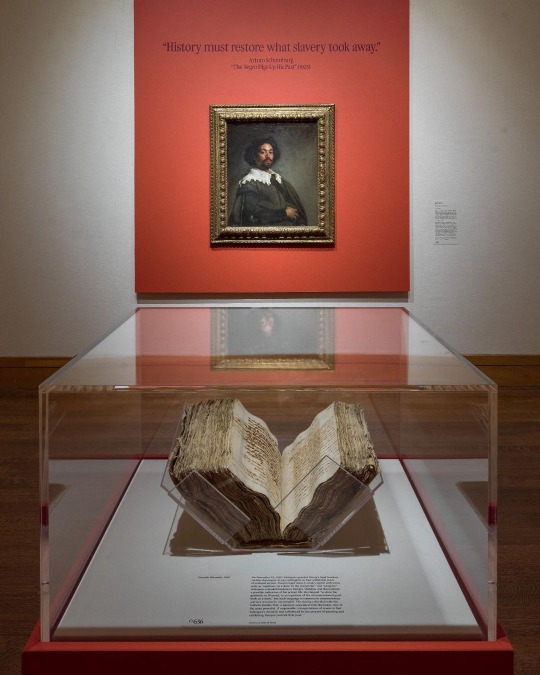
NOW ON VIEW—"Juan de Pareja, Afro-Hispanic Painter" shares an unprecedented look at the life and artistic achievements of Juan de Pareja.



The exhibition tells his story and examines the role of enslaved artisanal labor and a multiracial society in the art and material culture of Spain’s so-called “Golden Age.”



Representations of Spain’s Black and Morisco populations in works by Francisco de Zurbarán, Bartolomé Estebán Murillo, and Velázquez join works that chart the ubiquity of enslaved labor across media.
Visit now through July 16 to experience the first gathering of Pareja’s rarely seen paintings, some of enormous scale, which engage with the canons of Western art while reverberating throughout the African diaspora.
@schomburgcenter Have you seen our founder #ArturoSchomburg’s books, writings, and photos on display @metmuseum? They are part of the exhibition #JuandePareja, Afro-Hispanic Painter.
Mr. Schomburg’s materials offer the framework for discussing the painter. Pareja (c. 1608–1670) was enslaved and worked under famed Spanish painter Diego Velázquez (c. 1599–1660) for over two decades before becoming an artist in his own right.
Mr. Schomburg’s materials were invaluable resources to expand the conversation on Pareja and offers valuable insights on 17th–century Spain. They also provided insight into 17th-century Spain.
Dr. Vanessa K. Valdés, author of Diasporic Blackness: The Life and Times of Arturo Schomburg and associate provost for Community Engagement at The City College of New York, co-curated. Additionally, she wrote the essay “Arturo Schomburg, Juan de Pareja, and Afro-Hispanic Studies” for The Met’s exhibition catalog and served as its co-editor.
Images reposted from @metmuseum
#JuandePareja #MetMuseum #VanessaKValdés #BlackGirlArtGeeks
#Juan de Pareja#Afro-Hispanic Painter#Met Museum#exhibit#exhibit closing#Black Girl Art Geeks#Art Is A Weapon
0 notes
Text
Daily Current affairs of 2nd Feb 2023

Practice daily Current affairs and give quiz for assess your knowledge. Today you can study current affairs of 2nd Feb 2023 and this is suitable for almost all type of government competitive exams.
Daily Current affairs for 2nd Feb 2023
Q1. The Shanghai Cooperation Organization (SCO) Film Festival was held in which city in 2023?
A. Gandhinagar
B. Mumbai
C. Mysuru
D. Kochi
Answer Mumbai
Q2. Which country notified Pakistan of its intent to modify the 1960 Indus Waters Treaty (IWT)?
A. USA
B. India
C. Russia
D. China
Answer India
Q3. Which Union Ministry recently notified officials to act as members of Grievance Appellate Committees (GAC)?
A. Ministry of Electronics and Information Technology
B. Ministry of Home Affairs
C. Ministry of Finance Affairs
D. Ministry of Agriculture and Rural Development
Answer Ministry of Electronics and Information Technology
Q4. Road Transport and Highway Ministry announced to scrap all government vehicles older than how many years?
A. 10
B. 15
C. 20
D. 25
Answer 15
Q5. ‘Nidhi Aapke Nikat’ is an outreach programme of which institution?
A. RBI
B. IRDAI
C. EPFO
D. SEBI
Answer EPFO
Q6. As per the data by Government e-Marketplace (GeM), which state topped in the procurement of goods and services through GeM in 2022?
A. Odisha
B. Gujarat
C. Uttar Pradesh
D. Punjab
Answer Uttar Pradesh
Q7. Which of the following is the theme country of the 46th International Kolkata Book Fair?
A. Germany
B. Poland
C. France
D. Spain
Answer Spain
Q8. Who has been appointed as the new Drugs Controller General of India (DCGI) in January 2023?
A. Madhvendra Singh
B. Dr Rajeev Singh Raghuvanshi
C. Naresh Lalwani
D. Siddharth Sement Ahmeharma
Answer Dr Rajeev Singh Raghuvanshi
Q9. Who is the author of the book titled “The Poverty of Political Economy: How Economics Abandoned the Poor”?
A. Meghnad Desai
B. Dr Ashwin Fernandes
C. Vikram Sampath
D. Tamal Bandyopadhyay
Answer Meghnad Desai
Q10. When is the Indian Coast Guard Day celebration held each year?
A. 1 February
B. 2 February
C. 3 February
D. 4 February
Answer 1 February
Now Try Quiz of Feb Current Affairs 2023
Attention: You must prepare daily current affairs of Feb 2023 for Quiz, so you can rank better and motivate for your upcoming government exam competition.
Also practice other's day current affairs of Feb 2023
- Current affairs of 1st Feb 2023
- Current affairs of 2nd Feb 2023
- Current affairs of 3rd Feb 2023
- Current affairs of 4th Feb 2023
- Current affairs of 5th Feb 2023
- Current affairs of 6th Feb 2023
- Current affairs of 7th Feb 2023
- Current affairs of 8th Feb 2023
- Current affairs of 9th Feb 2023
- Current affairs of 10th Feb 2023
- Current affairs of 11th Feb 2023
- Current affairs of 12th Feb 2023
- Current affairs of 13th Feb 2023
- Current affairs of 14th Feb 2023
- Current affairs of 15th Feb 2023
- Current affairs of 16th Feb 2023
- Current affairs of 17th Feb 2023
- Current affairs of 18th Feb 2023
- Current affairs of 19th Feb 2023
- Current affairs of 20th Feb 2023
- Current affairs of 21st Feb 2023
- Current affairs of 22nd Feb 2023
- Current affairs of 23rd Feb 2023
- Current affairs of 24th Feb 2023
- Current affairs of 25th Feb 2023
- Current affairs of 26th Feb 2023
- Current affairs of 27th Feb 2023
- Current affairs of 28th Feb 2023
Read the full article
0 notes